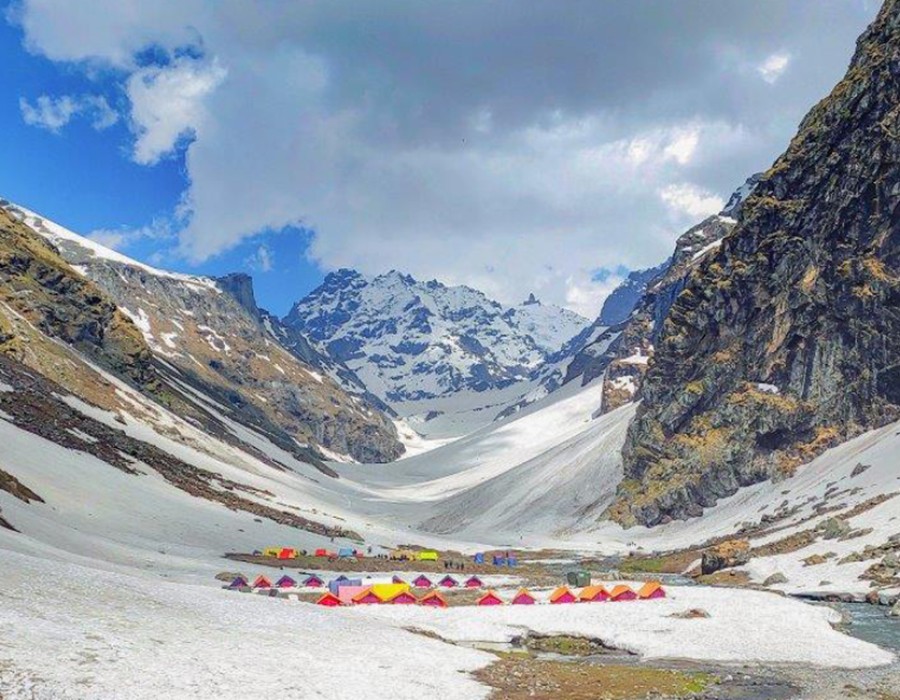Summary:
The Hampta Pass trek offers not only an incredible physical adventure but also a profound connection with the majestic Himalayan landscape and the cultural heritage of the region. It's an expedition that tests your endurance and rewards you with breathtaking vistas and encounters with the local traditions. Whether you're a seasoned trekker or a novice, the Hampta Pass trek promises a transformative experience.
In conclusion, the Hampta Pass trek is a journey of contrasts, an odyssey that traverses through diverse landscapes and cultures. Standing at the summit of Hampta Pass, gazing at the dramatic vistas that surround you, you'll realize why this trek has captured the hearts of trekkers from around the world. It's an invitation to embrace the grandeur of nature and embark on a life-changing adventure.
Preface:
The Himalayas, standing tall and majestic, have always drawn adventurers and trekkers to their awe-inspiring heights. Among the many trails that wind through these ancient mountains, the Hampta Pass trek stands out as a thrilling odyssey. This incredible journey takes you from the lush green valleys of Manali to the surreal landscapes of Spiti, offering a range of experiences that will leave you spellbound. In this comprehensive guide, we embark on a virtual exploration of the Hampta Pass trek, revealing its beauty, challenges, and the profound connection it offers with the Himalayan wilderness. The trek typically spans 5 to 6 days, covering around 26-30 kilometres. It falls under the category of moderate-level treks, making it suitable for both beginners and experienced trekkers. However, the challenging terrain and high altitudes require trekkers to be physically fit and acclimatised.
rekkers will come across picturesque campsites like Chika and Balu Ka Gera, offering stunning views and opportunities for altitude acclimatisation. A visit to the charming village of Hampta provides insights into the rich culture and traditions of the Himalayan people. The high point of the trek, Hampta Pass, presents a surreal landscape of rocky terrain, interspersed with snow patches, and breathtaking mountain vistas. The trek concludes at Chandratal Lake, a pristine crescent-shaped lake often referred to as the "Moon Lake," where trekkers can relax amidst nature's splendour.
1. Introduction to Hampta Pass:
Nestled in the Indian state of Himachal Pradesh, the Hampta Pass is a high-altitude mountain pass that links the beautiful Kullu Valley to the stark and stunning terrain of Lahaul and Spiti. What sets this trek apart is its dramatic transition from verdant landscapes to arid, high-altitude desolation, making it a paradise for trekkers and nature enthusiasts.
2. Trek Duration and Difficulty:
The Hampta Pass trek typically spans 5 to 6 days, covering a distance of approximately 26-30 kilometres. It's considered a moderate-level trek, making it accessible to both novices and experienced trekkers. However, due to the challenging terrain and high altitudes, physical fitness and proper acclimatisation are crucial.
3. Highlights of the Trek:
Manali's Natural Beauty: The journey begins in Manali, a renowned hill station celebrated for its lush greenery and tranquil ambiance.
Scenic Campsites: Along the route, trekkers encounter picturesque campsites like Chika and Balu Ka Gera, where they can soak in breathtaking views and acclimatise to the altitude.
Cultural Encounters: A visit to the charming village of Hampta provides a unique opportunity to immerse oneself in the rich culture and traditions of the Himalayan people.
Hampta Pass Summit: The pinnacle of the trek, Hampta Pass, presents a surreal and dramatic landscape characterised by rocky terrain, intermittent snow patches, and panoramic mountain vistas.
Chandratal Lake: The trek concludes at Chandratal Lake, a stunning crescent-shaped lake often referred to as the "Moon Lake," where trekkers can unwind amidst the pristine natural beauty.
4. Essential Trekking Information:
Permits: Trekkers must obtain the necessary permits, which may vary depending on the season and local regulations. It's essential to check and adhere to these requirements.
Acclimatisation: Given the high altitudes encountered during the trek, it is crucial to acclimate properly. Spending at least a day in Manali before commencing the trek is recommended.
Guides and Porters: Engaging the services of local guides and porters is advisable for safety and ease of navigation.
Weather: The weather in the Himalayas can be unpredictable, with conditions varying from warm sunshine to heavy rain or snow. Trekkers should pack accordingly, including warm clothing, rain gear, and sturdy hiking boots.
5. Best Time for the Trek:
The optimal time for embarking on the Hampta Pass trek is from June to September when the weather is relatively stable, and the trails are mostly snow-free. Trekkers are advised to avoid the monsoon season, particularly in July and August, to mitigate the risk of landslides.
6. Wildlife and Flora:
The trek provides opportunities to encounter the diverse Himalayan wildlife, including Himalayan ibex, snow leopards, and a variety of bird species. Additionally, the journey traverses through lush forests comprising pine, deodar, and oak trees, appealing to nature enthusiasts.
7. Camping Experience:
Camping is an integral aspect of the Hampta Pass trek. Nights under the star-studded Himalayan sky, shared stories around the campfire, and the tranquil sounds of nature create unforgettable memories.
8. Challenges and Precautions:
Altitude Sickness: Trekkers should familiarise themselves with the symptoms of altitude sickness and take necessary precautions, such as gradual ascent and acclimatisation.
Terrain: The trek's terrain varies, encompassing rocky paths, narrow ridges, and challenging sections. Trekkers should possess a reasonable level of fitness and balance.
Hydration: Maintaining proper hydration at high altitudes is crucial. Carrying an adequate supply of water and purification methods is essential.
Leave No Trace: Trekkers should adhere to the principles of "Leave No Trace," ensuring they minimise their environmental impact, refrain from littering, and respect the delicate ecosystem.





Comments